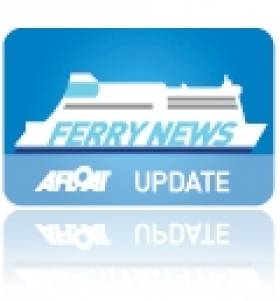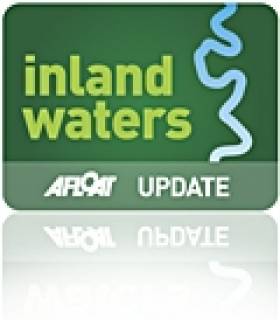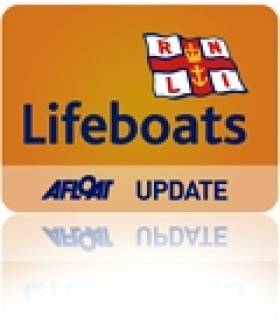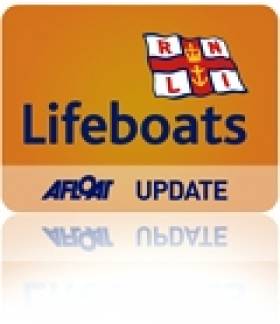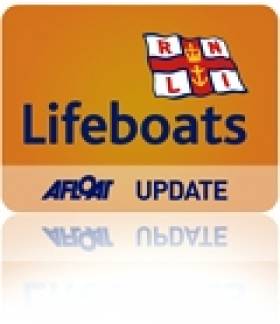Displaying items by tag: Wexford
Rosslare Europort to Host Irish Ports Conference
This year's Irish Ports Conference is to be hosted by Rosslare Europort on behalf of the Irish Port Association (IPA) and is to take place in Wexford on 30th September.
The event is the only one of its kind in Ireland this year where senior representatives from short-sea users, carriers, ports, logistics providers and the whole range of service providers meet to debate the topical issues of the day.
In addition the full-day conference provides those to network and explore further business opportunities and will culminate with the IPA's conference banquet.
The south-eastern ferry-port is to host delegates in the Ferrycarrig Hotel, just outside Wexford. For further information on booking and a (PDF) programme of the day visit the Rosslare Europort website by clicking HERE
Nothing Fishy About Donard Pupils' Prizewinning Musical
Pupils at Donard National School fended off competition from across Ireland to win a coveted prize in the Inland Fisheries Ireland 'Something Fishy' competition for 2011, the New Ross Standard reports.
Wexford footballer Brian Malone presented fifth and sixth class pupils at Donard NS with goodie bags and an award for their entry 'Something Fishy - The Musical', which features songs and dances about the ecosystem of their local River Boro.
Dr Ciaran Byrne, IFI chief executive Dr Ciaran Byrne, who was on hand at the prizegiving ceremony at the Wexford Education Centre in Enniscorthy, commented on all entrants: “You guys are the caretakers of this environment and if you take this message with you today we will have a much better environment in 20 years’ time.”
More than 160 schools and 7,000 children took part this year in the 'Something Fishy' initiative, which is now in its sixth year of encouraging primary schoolchildren to explore different aspects of fish life.
The Irish Times has more on the story HERE.
Celtic Link Ferries First Ferry Goes to the Breakers
Launched as the Stena Tranporter, the career of the 16,000 tonnes has spanned over three decades in which the 151m vessel changed through several owners and subsequent vessel renamings.
It was when she served under the name Baltic Ferry, that her most notable career took place in 1982 during her wartime deployment as part of the
Falklands Islands Task Force. The 151m vessel was requisitioned by the British Ministry of Defence which saw the ship engaged in military operations when RAF Harrier Jump-Jet aircraft transferred store supplies from the deck of the ship as part of the war-effort in the South Atlantic Ocean.
In 2001 the vessel undertook ferry operations to Ireland as the European Diplomat on the Dublin-Liverpool route for the P&O (Irish Sea) route network. The following year she was transferred on the direct route to France until P&O pulled the plug on the continental service in December 2004, leaving Irish Ferries as the sole operator.
It was not until February 2005 that the route resumed service but this time under new owners Celtic Link Ferries. The O'Flaherty brothers, owners of a large fishing fleet in Kilmore Quay purchased the vessel and renamed her Diplomat. See PHOTO.
For the next four years she built up a steady customer loyalty between freight-hauliers drivers and car-only accompanying passengers who were accommodated in the ship which had a limited passenger certificate for 114 passengers. In addition she had a license to transport livestock.
Currently Celtic Link Ferries operate the ferry Norman Voyager but the 800-passenger / 200-car ro-pax vessel will only remain on the route until an October debut of a larger sistership the Cartour Beta.
The vessel is running this season between Italy and Sicily and with an added deck the 27,552 tonnes vessel has an increased capacity for passengers, cars and enhanced range of facilities. Recently the company had run a competition to name the new vessel which is to begin a five-year charter on the service between Wexford and Normandy.
- Wexford
- irish sea
- Diplomat
- Celtic Link Ferries
- Kilmore Quay
- Stena Rederi
- Marine Express
- RosslareCherbourg
- Norman Voyager
- Ports and Shipping News
- Normandy
- RoPax
- DublinLiverpool
- P&O (Irish Sea)
- Ferry news
- Cartour Beta
- Irish Sea Ferries
- Stena Transporter
- Baltic Ferry
- European Diplomat
- O'Flaherty Brothers
- Falklands Islands Task Force
- Hyundai Heavy Industries
- Freighthauliers
- Livestock
- RAF
- Harrier JumpJets
Wexford to Host Irish Ports Conference 2011
The Irish Ports Conference 2011 is set for Friday 30 September in Wexford.
The theme of this year's one-day conference is 'Navigating a Sea of Change: Delivering Jobs Through Trade'.
Rosslare Europort will be hosting the event at the Ferrycarrig Hotel in Wexford Town.
Further information and booking details will follow shortly.
Firm Offers Security for Wexford Lifebuoys
A security firm based in Wexford town has offered electronic protection and 24-hour monitoring to Wexford County Council in a bid to secure funding for lifebuoys on Wexford Bridge.
According to the Wexford People, the move comes after a spate of accidents involving people falling from the bridge, which is one of the longest in Ireland. The original lifebuoys were removed several years ago due to vandalism.
SAR Ireland has more on the story HERE.
Four of the eight rowing boats involved in a triathlon got into difficulty as strong wind over tide caused dangerous waves which swamped the boats and capsized one. The boats were spotted by members of the Wexford Harbour Boat Club who had safety boats in the water as part of their weekly sailing practice. The Wexford RNLI Lifeboat was training at the time and came to the assistance of the rowers, some of whom were in the freezing water for ten minutes. Conditions were challenging with a southerly force 6 and wind over tide which resulted in seas of 3 foot waves, making it very difficult for the rowers. All rowers were brought ashore.
One hour after the callout, a man was spotted falling from Wexford bridge, at 1:09pm. The quick action of the public and the gardai ensured that the lifeboat, some of whose crew were still at the station was able to launch within minutes of the man entering the water. With the help of the gardai on the bridge who kept a visual on the man the lifeboat crew were able to locate him. The man was unconscious when lifeboat volunteer Frank O'Brien, jumped into the water and pulled him into the lifeboat. First aid was immediately adminstered and the casualty was brought back to the lifeboat station and met by a waiting ambulance.
Night in Igloo Raises funds for the RNLI
Brothers Rory (37) and Eoin (36) O'Connor spent last night (Thursday 2 December 2010) in an igloo on Duncannon beach in county Wexford to raise funds for RNLI lifeboats. The pair went into the home-made igloo at 8pm last night and emerged this morning at 8am.
The igloo was built on Duncannon beach by local men Patrick Byrne and David Walsh following plummeting temperature and heavy snowfall in the southeast. On hearing of the structure, Rory and Eoin approached the men to ask if they could spend a night in the igloo to raise funds for RNLI lifeboats. With their agreement they made plans to spend the evening in the ice and brought with them special clothing and sleeping bags to brave the arctic temperatures.
Rory is a volunteer lifeboat helm on Fethard-on-Sea D class inshore lifeboat in county Wexford and when the temperatures dropped on the south-east coast he and his brother Eoin decided to do something to raise funds for the RNLI and to remind people that lifeboat crew go out in all types of weather.
Speaking from the igloo at the end of their night Fethard lifeboat helm Rory said "We are honestly delighted with the response from the public to our sleepover. People were dropping by the igloo all night to say hello and drop some money in the bucket. We even had a local pub send down some hot whiskeys to keep us warm. It was actually quite comfortable and we even managed to get a good night's sleep."
The brothers emerged this morning in good spirits and were looking forward to a cooked Irish breakfast on the beach.
Rory and Eoin have set up a donations page HERE. The brothers have so far raised over €1,500 for the lifeboats.

A night in the cold has produced 1500 Euros so far!
The Tamar Arrives!... At Kilmore Quay
The lifeboat was funded by a legacy from Mrs Mary Weeks from Surrey in England who passed away in 2006. Mrs Weeks met her husband while on a cruise off the west coast of Scotland on a boat named Killarney.

The RNLB Killarney on her maiden arrival yesterday to Kilmore Quay, Co. Wexford.
She also has a strong RNLI connection through her maiden name Distin. Mrs Weeks was related to the Coxswain of Salcombe lifeboat Samuel Distin and to Albert Distin. Both men lost their lives in the Salcombe lifeboat disaster of 1916.
The lifeboat hull was moulded by the RNLI and fitted out in Plymouth under RNLI supervision. Lifeboat crewmembers based in Kilmore Quay have undertaken comprehensive training at the lifeboat college in Poole and onboard the Tamar class lifeboat in preparation for their new arrival.
The new lifeboat is not expected to go on service until later in the month and the next few weeks will be spent training the rest of the lifeboat crew on the new boat. RNLI Deputy Divisional Inspector Gareth Morrison said, " This is a huge day for the RNLI in Ireland. The arrival of any lifeboat is a great celebration for a community but when it is the first of a new class of lifeboat the excitement is even greater.
The Kilmore Quay lifeboat crew have been looking forward to this day for a long time. Their last lifeboat the Famous Grouse rescued over 300 people since 2004 and this lifeboat station has had many challenging rescues in its history. I wish them the very best of luck with their new lifeboat, may she have many successful years ahead of her." Kilmore Quay lifeboat Coxswain Eugene Kehoe added, "It's a proud day for Kilmore Quay.

The crew of the RNLB Killarney
A new lifeboat is a tremendous gift and we will take very good care of it. We are very grateful to the donor who by leaving this legacy to the RNLI has provided a lifeboat that will go on to save many lives at sea.
On a bad night miles out to sea it is good to know that we have a state of the art lifeboat and a highly trained lifeboat crew to respond to every situation." The new Tamar class lifeboat is 16.3 metres in length with a maximum speed of 25 knots compared to the 14.3 metres of the current Tyne class lifeboat stationed at Kilmore Quay, which has a maximum speed of 18 knots.
The lifeboat is self-righting and is fitted with an integrated electronics Systems and Information Management System, which allows the lifeboat crew to monitor, operate and control many of the boats systems from shock mitigating seats. The Tamar also carries a Y boat (an inflatable daughter boat) which is housed under the aft deck and deployed from a hinged door in the transom. The lifeboat has room for 44 survivors. It will replace the current Kilmore Quay Tyne class lifeboat The Famous Grouse, which will be retired to the RNLI relief lifeboat fleet.
Related Safety posts
RNLI Lifeboats in Ireland
Safety News
Rescue News from RNLI Lifeboats in Ireland
Coast Guard News from Ireland
Water Safety News from Ireland
Marine Casualty Investigation Board News
Marine Warnings
First 'Tamar' Lifeboat Arrives at Kilmore Quay on Wednesday
The RNLI's new Tamar class all weather lifeboat will arrive at Kilmore Quay in County Wexford next Wednesday (13 October 2010) at 5pm. This €3 million lifeboat will be the first of its class to be based at an Irish lifeboat station. It is the most modern and technically advanced lifeboat in the RNLI fleet.
The new lifeboat, which is to be named Killarney, will undertake a five day passage from Poole in England, calling at lifeboat stations at the Channel Islands, Fowey, Padstow and Fishguard before arriving it its new home at the RNLI Kilmore Quay lifeboat station next Wednesday.
The lifeboat hull was moulded by the RNLI and fitted out in Plymouth under RNLI supervision. Lifeboat crewmembers based in Kilmore Quay have undertaken comprehensive training at the lifeboat college in Poole and on passage onboard the Tamar class lifeboat in preparation for their new arrival.
The new Tamar class lifeboat is 16.3 metres in length with a maximum speed of 25 knots compared to the 14.3 metres of the current Tyne class lifeboat stationed at Kilmore Quay, which has a maximum speed of 18 knots. The lifeboat is self-righting and is fitted with an integrated electronics Systems and Information Management System, which allows the lifeboat crew to monitor, operate and control many of the boats systems from shock mitigating seats.
The Tamar also carries a Y boat (an inflatable daughter boat) which is housed under the aft deck and deployed from a hinged door in the transom. The lifeboat has room for 44 survivors. It will replace the current Kilmore Quay Tyne class lifeboat The Famous Grouse, which will be retired to the RNLI relief lifeboat fleet. The €3 million lifeboat has been funded from a legacy.
All are welcome to attend. The RNLI is inviting everyone interested to see the new lifeboat's arrival into Kilmore Quay Harbour to be in place before 5pm.
Tamar Arrival in Ireland
Event: First Tamar class lifeboat in Ireland to arrive at Kilmore Quay RNLI Lifeboat Station in County Wexford
Date: Wednesday 13 October 2010Time: 5pm at Kilmore Quay harbour in County Wexford
Related Safety posts
RNLI Lifeboats in Ireland
Safety News
Rescue News from RNLI Lifeboats in Ireland
Coast Guard News from Ireland
Water Safety News from Ireland
Marine Casualty Investigation Board News
Marine Warnings
Politicians Aim to Restart Courtown Marina Project with EU Cash
Wexford Councillors and County Council officials have come together to seek European assistance to help save the stalled Courtown marina, news of the move was published in the Gorey ECHO.
"This is precisely the kind of question our politicians we need to ask if we're ever to complete the necklace of marinas around our coastline, said the IMF's David O'Brien.
Plans for a 230-berth marina in Courtown were unveiled in November 2008 and included apartments and retail units. The plans also included the construction of a breakwater off the south pier in the village.
Childers visited the north Wexford seaside village to discuss the possibility of restarting the project which has been stalled since 2008 due to the economic recession.
Following her meeting with council officials and county councillors, Ms. Childers submitted a Parliamentary Question regarding the possibilities for getting financial assistance for marina facilities in Ireland.
In the question Childers says: "Is there funding opportunities or other supports available from the European Union in order to assist in providing finance for the development of marina facilities in Ireland to enhance our tourism product?"
Ireland, as an island nation, is working to develop its infrastructure as a destination for sailing holidays.
"The development of marinas in a sustainable fashion at key locations around the coast of Ireland to accommodate sailing and boating activities would benefit from investment from a tourism and economic development point of view." said Childers.
For every euro spent berthing in Courtown marina visiting sailors will spend 10 in the village, according to our research, says O'Brien. Huge Tourism benefits can literally come in on the tide, if only we had the infrastructure", he added.
The IMF is the national body that represents the marine leisure industry including the Irish Marina Operators Association (IMOA).
The County Council carried out a feasibility study which found that the marina had to be self-funding through sale of apartments and other units as there was no government funding for such developments.
Speaking this week, Director of Services with Wexford County Council, Niall McGuigan said: "It is currently not financially feasible but we hope for the best. We would be very eager for it to go ahead."
Mr. McGuigan said that the project was on hold until either funding became available, an investor was found or a combination of both.



























